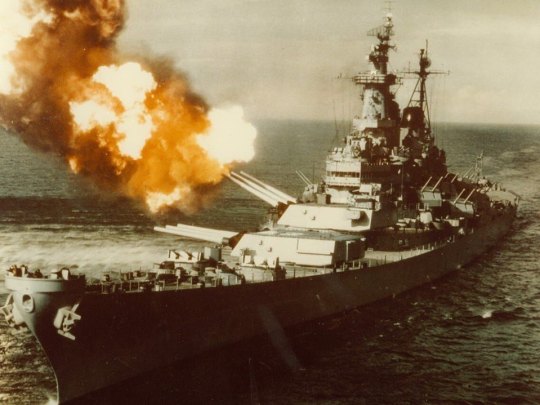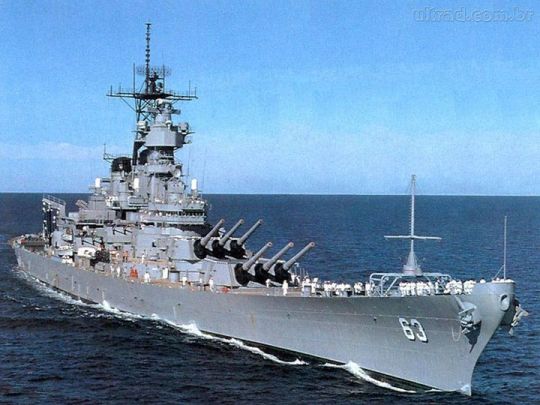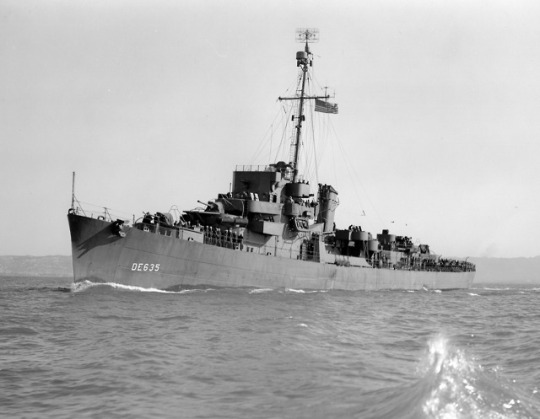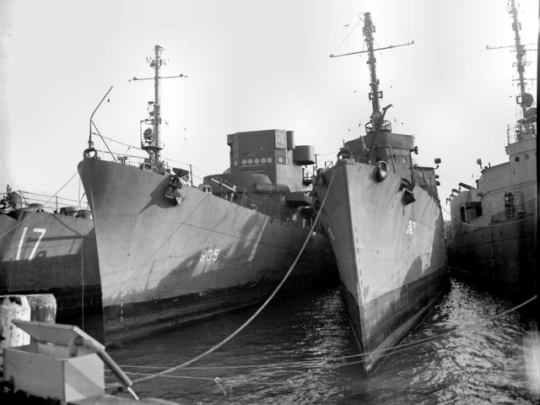#USS Missouri (BB-11)
Explore tagged Tumblr posts
Text

USS OHIO (BB-12), USS MISSOURI (BB-11) and USS WISCONSIN (BB-9) docked in Balboa, Canal Zone, Panama.
Photographed on July 16, 1915.
source
#USS Ohio (BB-12)#USS Ohio#USS Missouri (BB-11)#USS Missouri#Maine Class#USS Wisconsin (BB-9)#USS Wisconsin#Illinois Class#Predreadnought#Battleship#Warship#Ship#Balboa#Canal Zone#Panama#United States Navy#U.S. Navy#US Navy#USN#Navy#July#1915#my post
11 notes
·
View notes
Text

The U.S. Navy battleship USS Missouri (BB-63) at sea in the Pacific, circa early 1945, as seen from the aircraft carrier USS Intrepid (CV-11).
18 notes
·
View notes
Text

Iowa-class fast battleship USS Missouri (BB-63) at her commissioning ceremony at the New York Navy Yard, 11 June 1944. Photo looking aft from atop her No. Three 16-inch gun turret.
13 notes
·
View notes
Photo

USS Missouri (BB-63) about to be hit by a Japanese A6M Zero Kamikaze, while operating off Okinawa on 11 April 1945.
13 notes
·
View notes
Photo


Historic mail call....
WASHINGTON, DC (June 11, 2019) -- The United States Postal Service has issued a “Forever ® ” postage stamp (55-cents) celebrating the iconic battleship USS Missouri (BB 63)....and coinciding with the 75th anniversary of Missouri's commissioning into active duty on June 11, 1944 -- at the height of World War II.

USS Missouri saw service in the Pacific theater during the final year of World War II. (Above) On September 2, 1945, allied and Japanese officials gathered aboard the ship anchored in Tokyo Bay to sign the documents formally marking Japan’s surrender, and ending the war.

USS Missouri (BB 63) on patrol in the 1980s. The battleship fought in the Korean War in the early 1950s....was decommissioned for quite some time thereafter....then recalled to active duty for the Persian Gulf War in the early 1990s.

The great warship now lives on as a maritime memorial in Pearl Harbor, HI....moored close to the USS Arizona (BB 39) -- sunk at the beginning of World War II -- memorial....with the two battleships serving as the beginning and ending “bookmarks” to World War II.
#postage stamps#U.S. Postal Service#USPS#USS Missouri (BB 63)#history#warships#World War II#battleships
105 notes
·
View notes
Text
instagram
Missouri, Series: World War II Battleships, Palau, 2008, 10 Dollars, Silver (.999), Proof, Partially gilded, Mintage: 1000, 62,21 g, 42 x 42 mm
USS Missouri (BB-63) is an Iowa-class battleship and was the third ship of the United States Navy to be named after the U.S. state of Missouri. Missouri was the last battleship commissioned by the United States and is best remembered as the site of the surrender of the Empire of Japan, which ended World War II.
Missouri was ordered in 1940 and commissioned in June 1944. In the Pacific Theater of World War II, she fought in the battles of Iwo Jima and Okinawa and shelled the Japanese home islands, and she later fought in the Korean War from 1950 to 1953. She was decommissioned in 1955 into the United States Navy reserve fleets (the "Mothball Fleet"), but reactivated and modernized in 1984 as part of the 600-ship Navy plan, and provided fire support during Operation Desert Storm in 1991.
Missouri received a total of 11 battle stars for service in World War II, Korea, and the Persian Gulf, and was finally decommissioned in 1992 after serving a total of 17 years of active service, but remained on the Naval Vessel Register until her name was struck in 1995. In 1998, she was donated to the USS Missouri Memorial Association and became a museum ship at Pearl Harbor.
#coin#coincollection#coinhunting#coinphotography#coins#coinscollection#currency#hobby#numismatica#numismatist#battleship#ship#boat#boatlife#marine life#coincollecting#coincollector#coincollections#coincollectors#rare coins#silverstacking#silverstacker#silver#numizmatyka#numismatique#numismatics#numismatik#numismática#collection#missouri
1 note
·
View note
Photo

USS Missouri (BB-63). A 40mm barrel is seen impaled by a machine gun from the Japanese kamikaze hit off the coast of Okinawa on 11 April 1945. The gun looks to be a Japanese 12.7mm Type 389

85 notes
·
View notes
Text
75 Years Ago: The Surrender of Japan and the End of World War II
The spring of 1945 found the Japanese Empire in a desperate situation. The successful U.S. invasions of Iwo Jima in February and Okinawa in April had brought the Pacific War to the Japanese Home Islands’ doorsteps. Devastating air raids (alone the first firebombing raid on Tokyo during the night of 9/10 March 1945 claimed an estimated 100,000 lives) had razed the interconnected industrial/residential districts of most urban areas. The U.S. Navy’s highly effective submarine blockade, as well as the joint Navy–Army Air Forces aerial mining campaign, had brought about rapidly increasing shortages of food, fuel, and strategic materials that left both the Japanese military and civilian populace in dire straits. The Imperial Navy no longer had enough fuel reserves to go to sea and many ships had been relegated to the role of portside antiaircraft platforms. Strict conservation of available aviation fuel grounded most of Japan’s still considerable numbers of combat aircraft. Moreover, the Soviet Union had refused to renew its neutrality pact with Japan. Although the Japanese did their utmost to forestall immediate conflict with USSR, the country’s possessions on the Asian mainland (Manchuria and Korea) and the maritime territories to the north of the Home Islands were now vulnerable to a daunting potential foe.
These circumstances strongly pointed toward defeat and destruction. Secret assessments that Japan would not survive another year of war circulated in the highest Japanese government circles and it was clearly realized that the Home Islands would likely be invaded before the end of 1945. However, the country’s leadership remained divided over immediate courses of action at this juncture, with the emperor and a minority of his closest advisers from the Supreme Council for the Direction of War (the “Big Six”) tending to favor a peace agreement negotiated via the still-neutral USSR or other nonbelligerant nation and, on the other extreme, much of the Imperial Army’s leadership vowing to fight to the end. Overall, however, the humiliation of de facto surrender and the possible abdication of the emperor and the abolition of imperial reign still appeared impossible to accept.
Paradoxically, the Japanese Imperial Headquarters formulated a guardedly positive assessment of the immediate strategic picture: Allied—specifically American—war fatigue would preclude protracted blockade and aerial bombardment and had the potential to lead to a negotiated settlement. If Allied forces did, in fact, invade the Home Islands and the initial assault could be repulsed or made too costly for Western governments to bear, Japan would still be able to retain its honor. This view led to the formulation of a master defense plan (Ketsu-Go—“Decisive” Operation), which was completed in early April. Due to Japan’s geography, it was relatively easy to predict Allied landing areas. Ketsu-Go focused on these, with special emphasis on the Tokyo–Kanto Plain area and on the southern island of Kyushu, where the initial landings were expected.
Allied Invasion Planning
Allied war aims in regard to Japan, which were reiterated at numerious strategic planning conferences, had one goal: the enemy’s unconditional surrender. Clarity about the debate within the Japanese leadership continued to elude the West despite excellent intelligence derived from intercepts of encoded Japanese diplomatic and military message traffic (Magic and Ultra). Thus, the worst-case scenario—that of an unyielding foe who would fight to the death—had to be assumed and the invasion of the Home Islands planned. This view was reinforced by the extremely fierce fighting and correspondingly heavy losses experienced during the Battle of Okinawa and concurrent mass kamikaze attacks on Allied shipping.

USS Missouri (BB-63) about to be hit by a Japanese A6M Zero kamikaze while operating off Okinawa on 11 April 1945. The plane hit the ship's side below the main deck, causing minor damage and no casualties on board the battleship. (U.S. Naval History and Heritage Command photograph, NH 62696)
In preparation for the invasion of Japan, the U.S. Navy drew on some aspects of the pre-war War Plan Orange, which envisioned a steady Pacific advance leading to blockade and bombardment of the Home Islands. In contrast, the Army developed plans for an actual invasion. Into early 1945, inter-service disagreements over the varying approaches slowed integration of the Navy and Army concepts into a unified planning effort. On 25 May, just over two weeks after the surrender of Germany, the Joint Chiefs of Staff issued the general invasion order, leaving details to Army and Navy theater commanders. General Douglas MacArthur, Southwest Pacific Area supreme commander, submitted a more specific plan—which included input from Admiral Chester W. Nimitz, Jr., Pacific Ocean Areas commander in chief—on 28 May. The dual-phase Operation Downfall was to encompass an amphibious assault on the southwestern Home Island of Kyushu (Operation Olympic, November 1945), eventually followed by landings directly in the Tokyo–Kanto Plain area on Honshu (Operation Coronet, spring 1946). Although the latter operation was touted as a “knock-out blow” to Japan, planning assumptions explicitly did not exclude the possibility of fighting dragging into 1947. Moreover, Downfall would require redeployment of forces previously engaged in the European Theater. However, coupled with varying estimates of the large—even disastrous—numbers of expected Allied military and Japanese military and civilian casualties, indications of war weariness among the Allies made the defeat of Japan imperative within a twelve-month time frame.
Finale: A Brief Chronology
The primary subsequent events, which ultimately led to the Japanese surrender on 14 August, unfolded as follows:
May–August: Continuing build-up of Japanese forces on Kyushu gradually exceeds Allied planning assumptions, leading to a reevaluation of the human costs associated with Operation Olympic and injecting uncertainty into the notional Operation Downfall timetable.
1 June: With the atomic bomb program nearly concluded, President Harry S. Truman’s program advisers, the Interim Committee, advise use of the bomb as soon as possible. Target lists have been drawn up since April.
22 June: Despite military mobilization of the Home Islands, candid assessments of Japan’s situation lead Emperor Hirohito to request that “concrete plans to end the war, unhampered by existing policy, be speedily studied and that efforts made to implement them.” Third-party intercession is raised with the Soviet Union, which merely strings along Japanese diplomats and provides no concrete response to their overtures.
22 June: Okinawa is declared secure; total Allied personnel killed in action exceed 60,000; estimates of Japanese military and civilian deaths range from 110,000 to 250,000. The high civilian casualty rate is the result of totality of the Japanese mobilization effort, coercion of the civilian populace, and effective propaganda.
17 July–2 August: Potsdam Conference (Truman, Attlee, Stalin), held in Berlin, Germany; the joint declaration reiterates the call for Japan’s unconditional surrender. Specific terms include the loss of all Japanese territories outside the Home Islands, complete disarmament, and Allied occupation of Japan. Truman is informed of the successful atomic bomb test on 16 July, during the conference.
27 July: Terms of Potsdam Declaration are rejected by Japan; Truman had already approved the schedule to employ atomic bombs on 25 July.
6 August: The first U.S. atomic bomb is dropped on Hiroshima, an industrial center in western Honshu. An estimated 90,000 to 120,000 Japanese are killed. Despite recognizing the weapon’s destructive potential, the Japanese leadership estimates that the United States has only one or two additional bombs ready and decides to continue hostilities.
8 August: The Soviet Union declares war on Japan and invades Manchuria the following day.
9 August: The second U.S. atomic bomb is dropped on the large port city of Nagasaki, in Kyushu. An estimated 129,000 to 226,000 Japanese are killed. However, the “Big Six” and full Imperial Cabinet still cannot arrive at the necessary unanimous decision to accept the Potsdam terms and to surrender. Emperor Hirohito calls an imperial conference of all high-level advisers, an indication that he will accept the Allied terms, albeit with the proviso that the imperial house be preserved (a point left open in the Potsdam Declaration).
10 August: Hirohito makes the decision to surrender.
14 August: Hirohito’s surrender announcement to the Japanese nation is recorded. Despite an attempted last-minute coup by radical militarists, the message is broadcast. Japan agrees to surrender unconditionally.
2 September: The instrument of surrender is signed by representatives of the Allied and Japanese governments onboard USS Missouri (BB-63) in Tokyo Bay.

Fleet Admiral Chester W. Nimitz signs Japan's Instrument of Surrender aboard USS Missouri in Tokyo Bay. Behind him are (L to R): Douglas MacArthur; William F. Halsey, and Forrest Sherman (USN)
Carsten Fries is with the NHHC Communication and Outreach Division. This account appears courtesy of Naval History and Heritage Command, and it may be found in its original form here.
from Storage Containers https://www.maritime-executive.com/article/75-years-ago-the-surrender-of-japan-and-the-end-of-world-war-ii via http://www.rssmix.com/
0 notes
Text

USS MISSOURI (BB-11) and the Great White Fleet with USS MAYFLOWER (PY-1),
Photographed on December 1907.
National Library of France: ark:/12148/btv1b53206469v
#USS Missouri (BB-11)#USS Missouri#Maine Class#Battleship#predreadnought#Great White Fleet#USS Mayflower (PY-1)#USS Mayflower#President Yacht#warship#ship#December#1907#united states navy#us navy#navy#usn#u.s. navy#my post
52 notes
·
View notes
Text


March 31, 1992 – USS Missouri (BB-63), the last active American battleship is decommissioned. The USS Missouri (BB-63) (“Mighty Mo” or “Big Mo”), an Iowa-class battleship and was the third ship of the U.S. Navy to be named in honor of the US state of Missouri. Missouri was the last battleship commissioned by the United States and was the site of the surrender of the Empire of Japan which ended World War II. Missouri was ordered in 1940 and commissioned in June 1944. In the Pacific Theater of World War II she fought in the battles of Iwo Jima and Okinawa and shelled the Japanese home islands, and she fought in the Korean War from 1950 to 1953. She was decommissioned in 1955 into the United States Navy reserve fleets (the “Mothball Fleet”), but reactivated and modernized in 1984 as part of the 600-ship Navy plan, and provided fire support during Operation Desert Storm in January/February 1991. Missouri received a total of 11 battle stars for service in World War II, Korea, and the Persian Gulf, and was finally decommissioned on 31 March 1992, but remained on the Naval Vessel Register until her name was struck in January 1995. In 1998, she was donated to the USS Missouri Memorial Association and became a museum ship at Pearl Harbor, Hawaii.
47 notes
·
View notes
Text

Officers of the Imperial Japanese Navy cruiser Nisshin pose on the quarterdeck of USS Missouri (BB-11) with their American counterparts. The visit occurred during Missouri's visit to Yokohama during the voyage of the Great White Fleet.
28 notes
·
View notes
Photo

“USS Missouri (BB-63) at sea in the Pacific, circa early 1945, as seen from USS Intrepid (CV-11). This photograph was received by the Naval Photographic Science Laboratory on 28 April 1945.”
(NHHC: 80-G-316036)
#Military#History#USS Missouri#Battleship#United States Navy#US Navy#WWII#WW2#Pacific War#World War II
153 notes
·
View notes
Photo

USS Missouri (BB-63). A 40mm barrel is seen impaled by a machine gun from the Japanese kamikaze hit off the coast of Okinawa on 11 April 1945. [800 × 605] Check this blog!
3 notes
·
View notes
Photo

On June 11, 2019, the U.S. Postal Service celebrated the USS Missouri (BB-63) with the release of this new Forever stamp, coinciding with the 75th anniversary of the ship’s commissioning on June 11, 1944. A sheet of 20 Forever stamps #stampscollection https://www.instagram.com/p/B1QKIl-FpWq/?igshid=4c1jdbtoi0as
0 notes
Photo




Seventy-five years ago today, on 19 May 1944, USS ENGLAND (DE-635) sank Japanese submarine I-16, the first of six submarines ENGLAND would destroy in May.
She honored John Charles England, born in Harris, Missouri, on 11 December 1920. He enlisted in the Naval Reserve on 6 September 1940, and was commissioned an ensign on 6 June 1941. On 3 September 1941, he reported for duty aboard the Battleship USS OKLAHOMA (BB-37). Ensign England was killed in action during the Japanese attack on Pearl Harbor on 7 December 1941, when OKLAHOMA was torpedoed and capsized.
His namesake, USS ENGLAND, was launched on 26 September 1943, by Bethlehem Steel Company in San Francisco, California. She was sponsored by Mrs. H. B. England, the mother of Ensign England. The ship was commissioned on 10 December 1943, with Cdr. William B. Pendleton in command.
ENGLAND arrived at Espiritu Santo on 12 March 1944, from San Francisco, Pearl Harbor, Funafuti, and Guadalcanal. She took up escort duty between Espiritu Santo and Guadalcanal, occasionally sailing to Noumea, and once to the Marshalls.
On 18 May 1944, with two other destroyer escorts, RABY and GEORGE, ENGLAND cleared Port Purvis on a hunt for Japanese submarines during a passage to Bougainville. Thanks, in part, to Executive Officer John Williamson’s previous duty teaching ASW tactics at Miami, during the next 8 days, she was to set an impressive record in antisubmarine warfare, unmatched by any other American ship.
She hunted down and sank 1-16 on 19 May, RO-106 on 22 May, RO-104 on 23 May, RO-116 on 24 May, and RO-108 on 26 May. In three of these cases, the other destroyers were in on the beginning of the actions, but the kill in every case was ENGLAND's alone. Quickly replenishing depth charges at Manus, ENGLAND was back in action on 31 May, to join with four other ships in sinking RO-105.
This superlative performance won for ENGLAND a Presidential Unit Citation, and the assurance from the Chief of Naval Operations, Admiral E. J. King, "There'll always be an ENGLAND in the United States Navy." His pledge was fulfilled 6 October 1960, when DLG-22 was assigned the name ENGLAND. Sadly, the promise has not been kept today.
Through the summer of 1944, ENGLAND sailed throughout the northern Solomons, providing the escort services necessary for the building up of bases. She also continued to provide escort services that aided the preparations for the renewed assaults on Japanese territories to the north, and the provision of supplies to garrison forces on the islands of the southwest Pacific.
In August, she underwent repairs at Manus, and between 24 September and 15 October, voyaged from the Treasury Islands to Sydney, Australia. From the Treasuries she sailed, guarding a convoy to Hollandia, where she arrived on 18 October. Then, on the 26th, she got underway on the first of two voyages to escort reinforcement convoys to newly invaded Leyte. She returned to Manus and local escort duty on 2 December.
From 2 January 1945, ENGLAND escorted convoys between Manus and Ulithi, the major base for operations of the carrier task forces, and later to be the staging point for the assaults on Iwo Jima and Okinawa. The escort vessel sailed to Kossol Roads in February, bringing in a convoy later routed on to the Philippines, and then resumed her duty on the Manus-Ulithi sea lanes. She sailed from Ulithi on 23 March for the pre-invasion bombardment of Okinawa.
Then she returned to Ulithi to join the screen of two cruisers, guarding them back to Okinawa to join the 5th Fleet just after the initial assault on 1 April. Between 6 and 17 April, she voyaged to Saipan, screening empty transports. Next, she took up a screening and patrol station north of the Kerama Retto.
On 9 May 1945, while on station, ENGLAND was attacked by three Japanese dive-bombers. Gunfire from the ship blew off one wing of the first suicider, but failed to deflect the kamikaze from its one-way mission. The plane crashed into ENGLAND’s starboard side, at the main deck, below the bridge. A heavy explosion soon followed, and a burst of smoke and flame engulfed the destroyer escort's pilothouse and bridge. ENGLAND raced along out of control.
The minesweeper, VIGILANCE (AM-324), rang up full ahead and went to ENGLAND’s assistance. ENGLAND was brought under control and stopped, about four miles east of where she had been kamikazed. At 1920, VIGILANCE pulled alongside the burning destroyer escort. VIGILANCE found heavy fires blazing from the forward mess hall, up through the wardroom, forward 20-millimeter clipping room, radio room, pilothouse, and flying bridge. Afterwards, when ENGLAND’s fires were under control, VIGILANCE took the destroyer escort under tow.
Underway for the northern entrance of Kerama Retto at 2135, the two ships arrived at their destination two hours later. ENGLAND’s total casualties were horrific, with 37 of her men killed or missing, and 25 wounded. When ready for sea, ENGLAND sailed on to Leyte, where she received temporary repairs, putting her in shape for the long voyage home. On 16 July 1945, she arrived in Philadelphia for permanent repairs and conversion to a high-speed transport.
The end of the war, however, halted this work. She was decommissioned on 15 October 1945, and sold for scrap on 26 November 1946. This was the end of one of the great destroyer escorts.
0 notes
Text
New Forever stamp honors Battleship USS Missouri
The U.S. Postal Service unveiled a new Forever stamp this week to honor the American battleship USS Missouri (BB-63).
The famed battleship is being honored to coincide with the 75th anniversary of her commissioning on June 11, 1944.
The battleship was affectionately nicknamed “Mighty Mo,” and had one of the most historic roles during World War II. On Sept. 2, 1945, military officials from the Allied powers and imperial Japan convened on her deck and signed the documents confirming Japan’s surrender and ending the war.
USPS said the stamp art depicts Missouri from a low vantage point almost at sea level, cutting through the water at a moderate speed commensurate with entering or leaving port. Large and imposing in the frame, Missouri is shown in the disruptive camouflage she wore from her commissioning until a refit in early 1945. Clouds loom in the background, tinged with gold and rose from the sun’s rays.
Designed by art director Greg Breeding, the stamp features a digital illustration created by Dan Cosgrove.
from FOX 4 Kansas City WDAF-TV | News, Weather, Sports https://fox4kc.com/2019/05/12/new-forever-stamp-honors-battleship-uss-missouri/
from Kansas City Happenings https://kansascityhappenings.wordpress.com/2019/05/12/new-forever-stamp-honors-battleship-uss-missouri/
0 notes